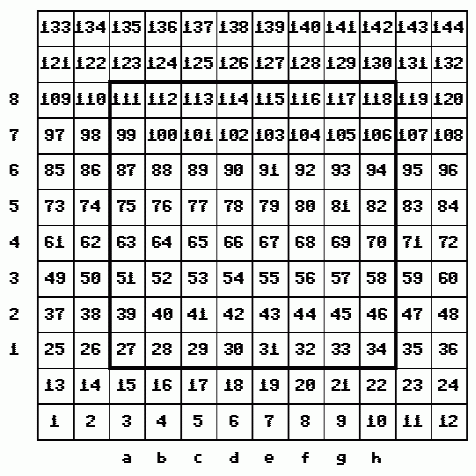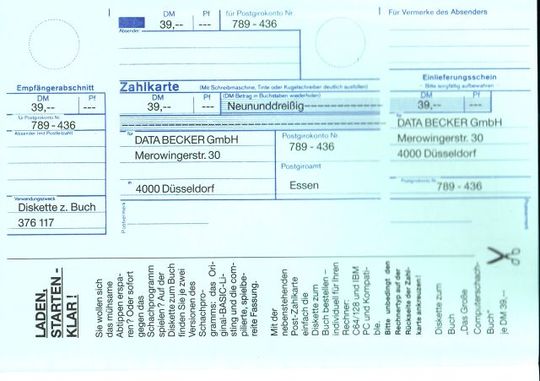Mas detalles del libro de ajedrez de Data Becker: http://manillismo.blogspot.com/2018/09/ajedrez-por-ordenador.html
https://www.c64-wiki.de/wiki/Das_grosse_Computerschachbuch
Description [ edit ]
It was not the intention of the authors to present a program that plays at the highest level, but to give basic insights into the structure of a chess program and to clearly explain its most important parts and their program structures.
The included program DEMOSCHACH was originally written on a Commodore SX64 and compiled with Basic 64 .
The included program DEMOSCHACH was originally written on a Commodore SX64 and compiled with Basic 64 .
From the blurb of the back of the book:
How does a chess program actually work ? Very few people know which algorithms can be used to teach the computer the royal game. This book provides information on all aspects of chess programming and includes a complete chess program in BASIC that vividly illustrates the programming issues and their solutions. The book is rounded off by a little history of computer chess and a lot of tips on how to play chess against the computer.
AND WRITTEN HAVE THIS BOOK:
Rainer Bartel is a specialist journalist and came across the subject of chess computers to EDP; he specializes in testing chess programs and winning against them. Hans-Joachim Kraas is a computer scientist and active chess player. His specialty is the evaluation functions, which ultimately decide on the playing strength of a program. Together with Günther Schrüfer, also a computer scientist and active chess player, he has developed the mainframe chess program BOBBY, which participated with substantial games at the Computer Chess World Championship 1983 in New York. Günther Schrüfer is one of the best connoisseurs of the algorithms of chess programs.
Rainer Bartel is a specialist journalist and came across the subject of chess computers to EDP; he specializes in testing chess programs and winning against them. Hans-Joachim Kraas is a computer scientist and active chess player. His specialty is the evaluation functions, which ultimately decide on the playing strength of a program. Together with Günther Schrüfer, also a computer scientist and active chess player, he has developed the mainframe chess program BOBBY, which participated with substantial games at the Computer Chess World Championship 1983 in New York. Günther Schrüfer is one of the best connoisseurs of the algorithms of chess programs.
Reading sample [ edit ]
3.3.3 One-dimensional Embedded Board Presentation
Here we use the technique of embedding. We do not code the board, but an extended board enlarged by two rows to each side. The field A1 corresponds to the index 27, H1 the index 34 and H8 the index 118. Diagram of the one-dimensional embedded board representation
Diagram of the one-dimensional embedded board representation
The numbers indicate the indices of the fields; For example, the field H8 has the index 118.
At the beginning of the program, the fields that do not belong to the board are assigned a unique value (14), which is never changed and identifies them as not passable. This solves the problem of edge detection. The ladies trains to the top right can now be generated as follows:
Here we use the technique of embedding. We do not code the board, but an extended board enlarged by two rows to each side. The field A1 corresponds to the index 27, H1 the index 34 and H8 the index 118.
 Diagram of the one-dimensional embedded board representation
Diagram of the one-dimensional embedded board representation The numbers indicate the indices of the fields; For example, the field H8 has the index 118.
At the beginning of the program, the fields that do not belong to the board are assigned a unique value (14), which is never changed and identifies them as not passable. This solves the problem of edge detection. The ladies trains to the top right can now be generated as follows:
100 REM DAMENZUEGE NACH RECHTS OBEN
110 REM STANDORT IST S
120 Z=S: REM ZIELFELD
130 Z=Z+13: REM 13 IST NUN DIE SCHRITTWEITE
140 IF BR(Z)=14 THEN GOTO 170: REM UEBER RAND GELAUFEN ?
149 REM FREIES FELD?
150 IF BR(Z)=7 THEN "ZUG EINTRAGEN": GOTO 130
160 IF BR(Z) "IST GEGNERISCHE FIGUR" THEN SCHLAGZUG EINTRAGEN"
170 REM FERTIGThis is obviously the most clever way to generate trains. Also with Springer trains we always land on the extended board, because we have increased it in each direction by 2 fields.
Contents [ edit ]
1. How did chess come to the machine - history of computer chess .......................... 5 1.1 The first chess machines ............................... 6 1.2 Theorists ............................................... 9 1.3 The era of mainframes ................................. 17 1.4 Super Giant ......... .................................... 36 1.5 Uprising of the Microphones ..................................... 46 2. How Does the Computer Learn to Win ? Theory of strategy games ........................... 57 2.1 The presentation of the game .................................... 58 2.2 The rules of the game ......................................... 60 2.3 The decision-making process .............................. 64 3. Always up to date - search strategy and game tree ...... ..................... 85 3.1 Programming - Art and Technology ....................... 85 3.1.1 Program development ..................................... 85 3.1.2 Program Organization .................................... 86 3.1.3 The Stack ............................................. .. 87 3.1.4 Special features of BASIC ................................ 97 3.2 Structure of a chess program ........................... 99 3.2.1 The components ........................................ 99 3.2.2 Dependencies ..................................... 100 3.2.3 The basic concept ....................................... 101 3.3 The train generator ....................................... 103 3.3.1 Two-dimensional board presentation ...................... 104 3.3.2 One-Dimensional Compact Board Presentation ............. 106 3.3.3 One-dimensional Embedded Board Presentation .......... 107 3.3.4 The train generator as a whole ............................. 108 3.4 Searching and Deciding ................................. 109 3.4.1 The evaluation function ................................. 110 3.4.2 The Minimax Search ........................................... 112 3.4.3 The Alpha Beta Algorithm ............................. 120 3.4.4 The search for peace ....................................... 129 3.4.5 Chess, dull, stalemate and the search for peace ................... 139 3.4.6 Variable search depth ..................................... 149 3.4.7 The iterative search .................................... 152 3.4.8 Train selection and train sorting ......................... 164 3.5 The position evaluation ................................. 170 3.5.1 Introduction ............................................. 170 3.5.2 The material evaluation .................................. 175 3.5.3 The positional evaluation ............................. 189 3.6 Auxiliary routines ............ ................................... 261 3.7 Input / Output Routines ............ ........................ 263 3.8 The lot management ................................... 264 3.8.1 The position entry ................................... 265 3.8.2 The party loop ..................................... 267 4. The program ... ........................................ 269 4.1 The Data Structures and Modules at a Glance .. .......... 270 4.2 The basic data structures ...................... 272 4.2.1 Positional presentation ................................... 272 4.2.2 Train presentation ......................................... 281 4.2.3 The train lists ............ ............................. 282 4.3 Declarations. ......................................... 284 4.4 Initializing and Reading the Partial Position .. ........ 287 4.5 The train generator ...................................... .. 292 4.6 The evaluation function .................................... 300 4.6.1 The control of the sequence ............................. 301 4.6.2 The position analysis ................................... 306 4.6.3 The peasant movement ..................................... 308 4.6.4 The figure evaluation ................................... 312 4.6.5 The royal evaluation .................................... 316 4.6.6 The Matt Routines ........................................... 322 4.7. Deepening Trains and the Stack .................. 324 4.8 General Auxiliary Routines ..................... .......... 330 4.9 The search and specific auxiliary routines ................ 333 4.9.1 The Auxiliary Routines ...................................... 334 4.9.2 The search ............................................. 340 4.10 Batching and input ....................... 346 4.11 Output routines ........ ....... ......................... 351 4.12 Variable reference list .................... ............ 352 5. How to play chess against computers .................... 359 5.1 Test your chess program .......................... 360 5.1.1 Which strategy? ..................................... 361 5.1.2 Initiative test .......................................... 364 5.1.3 Opening Library ................................... 367 5.l.4 Positional strengths and weaknesses ..................... 373 5.1.5 Compute Depth ............................................. 378 5.1.6 Permanent Brain ........................................ 384 5.1.7 King Tower Endgame .................................... 386 5.1.8 Subconvertions ..................................... 389 5.2 How to Beat a Chess Program - 7 golden rules to win .......................... 390 5.2.1 Unusual openings .............................. 393 5.2.2 Playing the Gambit ......................................... 397 5.2.3 No tactical complications - provoke exchange ................................. 404 5.2.4 Set traps ......................................... 406 5.2.5 If possible, aim for the endgame - Handle the final game in a plan .......................... 416 5.2.6 What do you have from it? ................................... 421 6. Appendix ........... ..................................... 423 6.1 List of mentioned programs and chess computer ..................................... 423 6.2 Bibliography ................................... 424 6.3 Complete Listing: DEMOSCHACH ......................... 428
Order card [ edit ]
Opinion [ edit ]
Peter : "An exemplary detailed book on the subject of computer chess, you have to understand a bit of chess and be willing to spend a lot of time studying the book.The fact that the examples are written in BASIC V2, makes the C64-BASIC Fan of course (others certainly less). "



No hay comentarios.:
Publicar un comentario